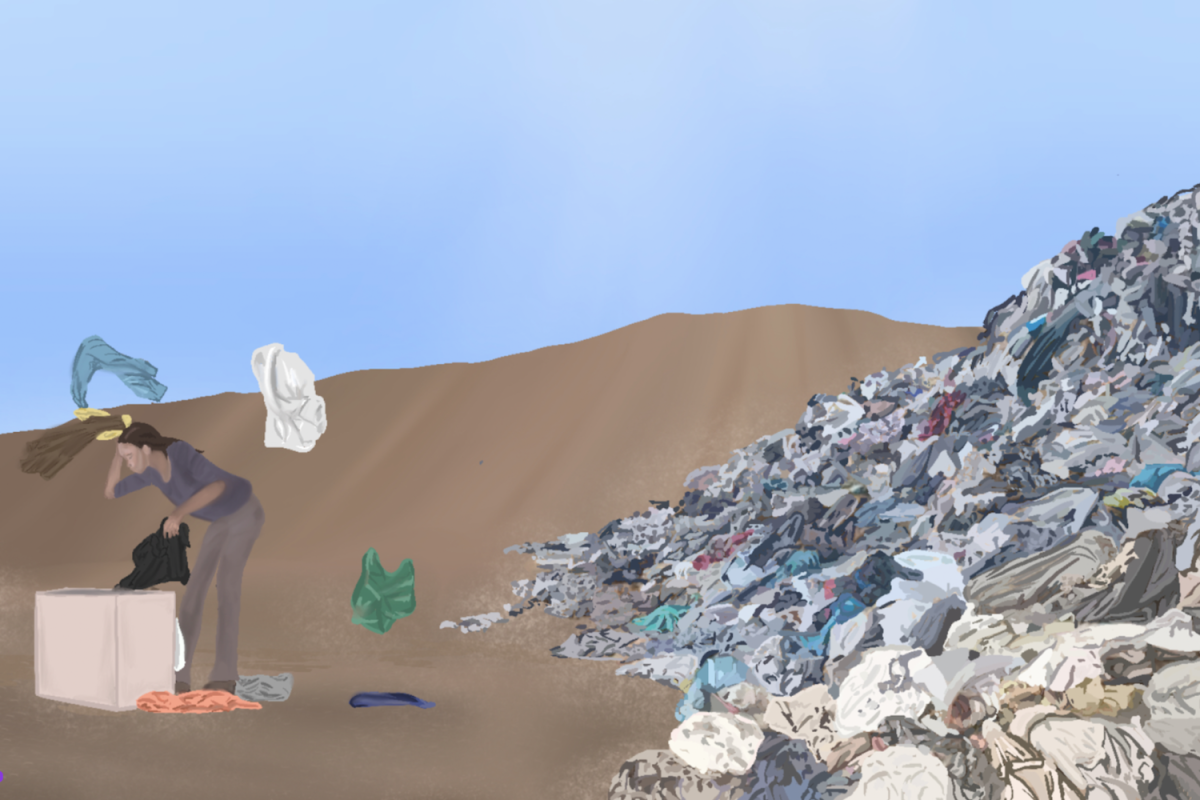When it came time for Jack Henry Richman (’24) to buy his prom suit, he knew the first place to look would be through the racks of a second-hand shop. Richman not only opted for vintage because of its stylish appeal, but also because he has been a consistent second-hand shopper since the age of 14. Despite scouring various thrift stores, he found each suit with a price tag of 200 to 300 pounds.
“That made me realize the primary reason that a lot of people aren’t shopping sustainably is because it’s become so unbelievably expensive,” Richman said.
Buying a brand new Moss Bros suit was more of a reasonable purchase for Richman. Thousands of miles away in a pile of trashed clothing in the Atacama Desert, lie many more prom suits that were also once worn.
In fact, the mountain of discarded and unsold clothes has become so unmanageable that it is now seen clearly from satellites in space, according to Business Insider. Climate experts say this imposes issues for the planet’s health, and feel the root of the problem is the accessibility, affordability and attractiveness of fast fashion clothing.
Visual Arts Teacher Robyn Zellar said although the magnitude of fast fashion is shocking, there have been warnings like these in the fashion industry in the past, and the “wake-up call happened a few years ago.”
Similarly, Richman said for people involved in sustainability, the discarded clothing in Chile is nothing they haven’t heard.
“I’m not really surprised by it because there has been another great garbage patch the size of Texas floating in the ocean,” Richman said.
Sustainable fashion enthusiast Maya Hu Dobbert da Cruz (’26) said she feels people will continue their fast fashion habits regardless of how much the issue is debated.
“It’s going to keep on going even though many people have heard about it,” da Cruz said. “It hasn’t really been changing.”
Sofia Limena (’24) said she believes part of the problem is the lack of coverage the issue receives in Chile is harmful to the people living near the dump, as they are unaware of the dangerous environment they are living in. Limena said the lack of “transparency with it” is devastating.
Likewise, Richman said he feels disappointed in how poorly the situation has been handled.
“It is not the best feeling knowing that there is just a mountain of unused clothing just sitting somewhere,” Richman said.
Similar to Richman, Zellar said it is also really “disheartening” to think about the origin and production of those clothes.
Zellar said people are often unaware that the majority of the clothes that they donate to charity shops reenter the market for fast fashion.
“Their hearts are in the right place, yet 90% of clothes that are brought to charity shops are exported,” Zellar said.
According to Cosh, prices for second-hand clothes have been increasing because of thrifting’s rise in popularity. Subsequently, Richman said the main factor influencing people to shop for fast fashion is its cheapness.
“I think the reason that fast fashion has had such a rise is because second-hand clothes have become so expensive,” Richman said.
Limena said social media and the rise of micro trends in young people’s fashion have made it difficult for them to adhere to sustainable practices.
“There’s also the competitive aspect of trends and people watching videos online, ” Limena said. “[Thrifting] has become more of a trend to shop sustainably instead of caring about why you’re shopping that way.”
Zellar said it is important to consider buying less frequently, and instead attempt to give items directly to a family member or friend.
Da Cruz makes her own sustainably sourced clothing and always buys clothing second-hand. She said she shops for fast fashion at a maximum of once or twice a year.
Although Zellar consistently purchases pre-owned clothing, she occasionally gives into shopping fast fashion when needed.
“I’m somebody who wears second-hand clothes every single day, but that doesn’t mean that I don’t ever buy fast fashion,” Zellar said, pointing to her shoes. “I’m wearing Hokas.”
The rule that I follow is I have basics which I buy from usually a more expensive or higher quality place because they last longer.
— Sofia Limena ('24)
Richman said he avoids buying clothing from fast-fashion companies by not giving into the latest trends and opting for timeless pieces.
“I try not to follow a trend,” Richman said. “I try and just think of what fundamentally will look good forever.”
Like Richman, Limena purchases her clothing conscious of the environment and the item’s life expectancy. According to Panaprium, the average high-street garment is worn seven times before being thrown out, while it can actually be sustained for more than two years.
“The rule that I follow is I have basics which I buy from usually a more expensive or higher quality place because they last longer,” Limena said. “The pieces that are a bit more unique I buy from independent brands or small businesses, and obviously vintage shops as well.”
Ultimately, Zellar said she is conscious of her old shopping habits and the amount of clothes she has given away to charity shops.
“I have been a big buyer of fast fashion in my past,” Zellar said. “All the clothes that I’ve probably ever bought are either sitting in the landfill or burning now or buried in the ground. I do think it weighs heavy on me.”











